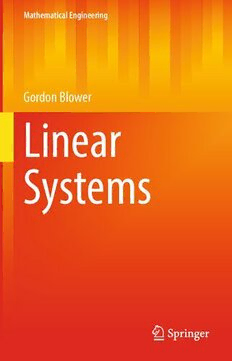
Linear Systems PDF
Preview Linear Systems
Mathematical Engineering Gordon Blower Linear Systems Mathematical Engineering SeriesEditors Jörg Schröder, Institute of Mechanics, University of Duisburg-Essen, Essen, Germany Bernhard Weigand, Institute of Aerospace Thermodynamics, University of Stuttgart,Stuttgart,Germany Jan-PhilipSchmidt,UniversitätofHeidelberg,Heidelberg,Germany AdvisoryEditors GünterBrenn,InstitutfürStrömungslehreundWärmeübertragung,TUGraz,Graz, Austria DavidKatoshevski,Ben-GurionUniversityoftheNegev,Beer-Sheva,Israel JeanLevine,CAS- MathematiquesetSystemes,MINES-ParsTech,Fontainebleau, France Gabriel Wittum, Goethe-University Frankfurt am Main, Frankfurt am Main, Germany Bassam Younis, Civil and Environmental Engineering, University of California, Davis,Davis,CA,USA Today,thedevelopmentofhigh-techsystemsisunthinkablewithoutmathematical modeling and analysis of system behavior. As such, many fields in the mod- ern engineering sciences (e.g. control engineering, communications engineering, mechanicalengineering,androbotics)callforsophisticatedmathematicalmethods inordertosolvethetasksathand. The series Mathematical Engineering presents new or heretofore little-known methods to support engineers in finding suitable answers to their questions, presentingthosemethodsinsuchmannerastomakethemideallycomprehensible andapplicableinpractice. Therefore,theprimaryfocusis—withoutneglectingmathematicalaccuracy—on comprehensibilityandreal-worldapplicability. Tosubmitaproposalorrequestfurtherinformation,pleaseusethePDFProposal Formorcontactdirectly:Dr.ThomasDitzinger([email protected]) IndexedbySCOPUS,zbMATH,SCImago. Gordon Blower Linear Systems GordonBlower DepartmentofMathematicsandStatistics LancasterUniversity Lancaster,UK ISSN2192-4732 ISSN2192-4740 (electronic) MathematicalEngineering ISBN978-3-031-21239-0 ISBN978-3-031-21240-6 (eBook) https://doi.org/10.1007/978-3-031-21240-6 MathematicsSubjectClassification:93C05,93B52,15A16,34D08 ©TheEditor(s)(ifapplicable)andTheAuthor(s),underexclusivelicensetoSpringerNatureSwitzerland AG2022 Thisworkissubjecttocopyright.AllrightsaresolelyandexclusivelylicensedbythePublisher,whether thewhole orpart ofthematerial isconcerned, specifically therights oftranslation, reprinting, reuse ofillustrations, recitation, broadcasting, reproductiononmicrofilmsorinanyotherphysicalway,and transmissionorinformationstorageandretrieval,electronicadaptation,computersoftware,orbysimilar ordissimilarmethodologynowknownorhereafterdeveloped. Theuseofgeneraldescriptivenames,registerednames,trademarks,servicemarks,etc.inthispublication doesnotimply,evenintheabsenceofaspecificstatement,thatsuchnamesareexemptfromtherelevant protectivelawsandregulationsandthereforefreeforgeneraluse. Thepublisher,theauthors,andtheeditorsaresafetoassumethattheadviceandinformationinthisbook arebelievedtobetrueandaccurateatthedateofpublication.Neitherthepublishernortheauthorsor theeditorsgiveawarranty,expressedorimplied,withrespecttothematerialcontainedhereinorforany errorsoromissionsthatmayhavebeenmade.Thepublisherremainsneutralwithregardtojurisdictional claimsinpublishedmapsandinstitutionalaffiliations. ThisSpringerimprintispublishedbytheregisteredcompanySpringerNatureSwitzerlandAG Theregisteredcompanyaddressis:Gewerbestrasse11,6330Cham,Switzerland To Jian Preface Thebookisaboutthemathematicsoflinearsystems, particularlycontinuoustime autonomous linear systems with finite-dimensional state space. These cover an interesting range of applications in science and engineering and are basic to the study of more complex systems. The material is at a level suitable for a third or fourthyearundergraduatestudentinaUKuniversity.Weassumethatthereaderis familiarwithcalculus,linearalgebraandbasiccomplexanalysisanddevelopthese ideasfurtherwithintheparticularcontextoflinearsystems. Chapter 1 is about how to describe linear systems by differential equation, block diagramsand linear algebra.One of the attractionsof linear systems is that they can be discussed in several different ways. Chapter 2 begins the systematic development of the theory, where methods of linear algebra are used to describe linear systems and compute transfer functions. The purpose of transfer functions is deferred until Chap.4, where they are introduced in parallel via the Laplace transform.InChap.2,weuseonlybasiclinearalgebra,whileinchapterthreemore advancedtechniquesareintroduced.Inmostcases,theresultsareprovedindetail, and thereare indicationsabouthow the mathematicalquestionscan be posedin a formsuitableforcalculationviaMATLAB.Acrucialaspectoflinearsystemstheory isitsadaptabilitytotreatsystemsofveryhighdimension,forwhichcomputersare essential. Some readers may wish to defer the final few sections of Chap.3 until later.Moregenerally,somesectionsofthebookaremorechallengingthanothers, andreaderscanpassoversomeresultsiftheyfindthemdifficult. In Chap.4, we give a conventional discussion of the Laplace transform for functionson (0,∞) with basic applicationsto differential equations. Inversionof Laplace transformsis a complicated topic, and in this book we give some special casessuchasHeaviside’sexpansiontheorembeforeaddressingthegeneralcasein Chap.6;thisisconsistentwiththehistoricaldevelopmentofthesubject.Methodsof vii viii Preface complexanalysisaremainlydeferreduntilChap.5.WealsocovertheFouriercosine transformandobtainaninversionformulafortheL1cosinetransform.TheFourier transform is essential for applications to signal processing, which are pursued in Chap.10. In Chaps.5, 6, and 7, we consider three approaches to the stability problem. Chapter5usesmethodsofcomplexanalysisandgeometricfunctiontheorytohelp us visualize the transfer function in terms of its Nyquist contour. In Chap.6, we presentalgebraicapproacheswhicharealgorithmicandcanbecarriedoutinexact arithmeticwithoutapproximation.TheninChap.7weuselinearalgebrainamanner thatisespeciallysuitedtolargematrices.Alloftheseapproachesaremosteffective when they are implemented with the aid of computers, and for large systems, computers are essential. Although these approaches are separated into distinct chapters,thedifferencebetweenthemshouldnotbeoverstated.Theyaredifferent routes towardsthe same goal and the same problemcan be expressed in different butequivalentwaysintermsofLaplacetransforms,polynomialsormatrices.Also, some families of transcendental functions such as the Bessel functions can be convenientlydescribedintermsofalgebraicdifferentialrings. In Chap.8, we consider orthogonal polynomials. This topic is often taught alongsidenumericalanalysis,asexamplesinthetheoryofdifferentialequationsor asanapplicationofHilbertspacetheory.Inthisbook,weemphasizethatsequences of orthogonal polynomials can be generated efficiently using discrete time linear systems, which make use of the three term recurrence relation. In applications to signalprocessing,itiscommontouseexamplessuchastheChebyshevpolynomials tocreatefilters,andtheseareparticularlywellsuitedtoourapproach.Thechapter covers some of the other classical orthogonal polynomials, such as the Laguerre system,whichwelaterusetoprovefundamentalresultsaboutFourierintegrals. Chapter9isconcernedwithGreen’sfunctions,inthesenseofCauchytransforms ofanintegrableweightonaboundedrealinterval.Thishasobviousapplicationsto orthogonalpolynomialsandmoments,andsomelessobviousapplicationtorandom linear processes. Some of these results describe fundamentalexamples in random matrixtheorysuchasthesemicirclelaw.Therearediverseapplications,suchasthe famousMay-Wigner law in mathematicalbiology,which demonstrate how useful linearsystemsareintreatingcomplexproblemsinmanybranchesofscience. The results of the first nine chapters mainly apply to linear systems with finite dimensionalstate spacesandthefinitematricesthatoperateonthem.InChap.10, we introduce Hilbert space with a view to describing some infinite-dimensional linear systems. As soon as one attained the generality of Hilbert space, one realizes the need to have suitably adapted tools with which to carry out explicit computations. For this reason, we introduce Hardy space on the right half-plane with its orthonormal basis derived from the Laguerre functions. The intended Preface ix application of these is to signal processing, and in Chap.11 we include famous results such as Shannon’ssampling theorem for band limited functions.Although the historical development had an interlude of several decades, it is now natural tofollowthisdirectlywiththeShannonwaveletbasisforL2.Thebookconcludes withadiscussionofTelatar’smodelofwirelesstransmission,whichisoftencalled ‘single user MIMO’. This is an important instance where random matrix theory entersintolinearsystemsandsuggestsareasforfurtherstudy. Chapters 1 and 2 are essential for understanding the rest of the book. Then readerswhoaremainlyinterestinginlinearalgebracanprogresstoChaps.3and7. Chapters 4 and 5 feature Laplace transforms and do not depend on the more advanced tools from linear algebra. Chapters 8 and 9 are best read together, and thesefeednaturallyintoChap.10.ThefinalChap.11requiresChaps.9and10.The followingdiagramindicatesthislogicaldependence. There are many aspects of control theory that we do not discuss in this book. Reliability, cost of manufacture,usability and tuning of componentsare all importanttopicsthatweleavetobooksthatemphasizeengineering. This book is based on lectures for a third-yearmodule at Lancaster University formathematicsstudentsandseveralprojectsforstudentsinmathematics,physics andenvironmentalscience.Iamgratefultothesestudentsforhelpfulcommentson the course materials which progressively improved the module. The module also benefitedfromahelpfulreviewbymycolleaguesNadiaMazzaandDavidTowers, whopersuadedmetoincorporateprojectsintothemoduleassessmentandenabled students to work on more extended exercises. Lucinda Hadley’s PhD thesis on wirelesscommunicationsuggestedsomeofthecontemporarytopics.Iamgrateful toRemiLodhofSpringerwhohelpedguidetheproject.AformerstudentYufeiLi proofreadthemanuscriptanderadicatedseveralerrors.
